

Pumpkin Treats
Pumpkin Crumble
Servings 10
INGREDIENTS
1 can pumpkin
1 can evaporated milk
1 cup brown sugar
2 eggs
1 tablespoon pumpkin spice
1 teaspoon cinnamon
1 box cake mix yellow, white or spice
3/4 cup chopped pecans
3/4 cup chopped white chocolate chips
1 1/2 cups melted butter
Whipped Cream:
Pumpkin French-Style Cheesecake
1 cup heavy whipping cream
2 tablespoons sugar
DIRECTIONS
1. Heat oven to 350 F.
2. In bowl, mix pumpkin, evaporated milk, brown sugar, eggs, pumpkin spice and cinnamon. Pour into greased 9-by-11-inch baking dish.
3. In separate bowl, mix cake mix, pecans and white chocolate chips. Sprinkle over pumpkin mixture. Pour butter evenly over top. Do not mix or stir. Bake 1 hour.
Recipe courtesy of “Cookin’ Savvy”
crushed pecans for serving
DIRECTIONS


INGREDIENTS
1 package softened cream cheese 8 ounces
1 can pumpkin pie purée
1/2 cup brown sugar
1/4 cup powdered sugar
1 1/2 tablespoons pumpkin pie spice
1 cup whipping cream
1 box gingersnaps
Whipped Cream
1 cup heavy whipping cream
2 tablespoons sugar crumbled gingersnaps for serving
White Chocolate and Pumpkin Pie Spice Popcorn Bites
1. To make pumpkin cheesecake dip: In large bowl, using hand mixer, mix cream cheese, pumpkin, brown sugar, powdered sugar, pumpkin pie spice and whipping cream. Serve on platter or in bowl with gingersnaps.
2. To make whipped cream: Using hand mixer, whip whipping cream and sugar until thick.
3. To make pumpkin parfaits: In small glasses, layer crumbled gingersnaps, pumpkin cheesecake mixture and whipped cream. Top with crushed pecans.
culinary.net
popcorn in large mixing bowl.


Servings 12
INGREDIENTS
12 cups unsalted, unbuttered popped popcorn
3 cups chopped white chocolate or white chocolate chips
1 tbsp light olive oil
2 tsp pumpkin pie spice
1 tsp flaked sea salt crushed
DIRECTIONS
1. Line large, rimmed baking sheet with parchment paper or wax paper. Place
2. In microwave-safe bowl, combine white chocolate, olive oil and pumpkin pie spice; microwave on medium 2-3 minutes, or until melted and smooth, stirring after each minute.
3. Pour melted white chocolate mixture over popcorn; add toffee bits and toss to combine. Transfer to prepared baking sheet, spreading to edges of pan; sprinkle sea salt over top.
4. Let cool; refrigerate 1-2 hours, or until set. Break into chunks for serving.
Tip: Homemade pumpkin pie spice can be made by combining 3 parts ground cinnamon with 1 part ground nutmeg, 1 part allspice and 1 part ginger.
culinary.net

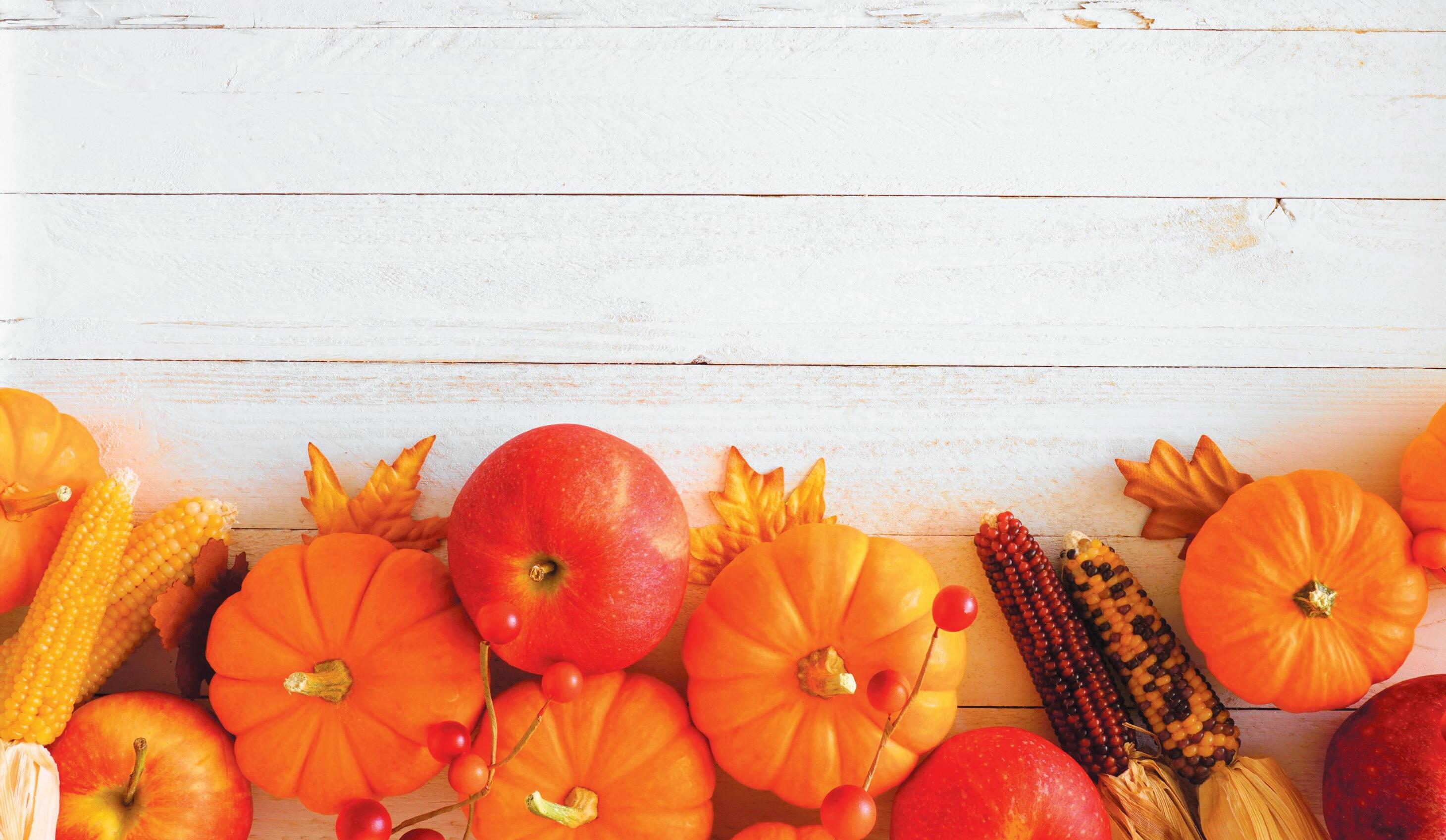
It’s
already!
Victoria Ledden
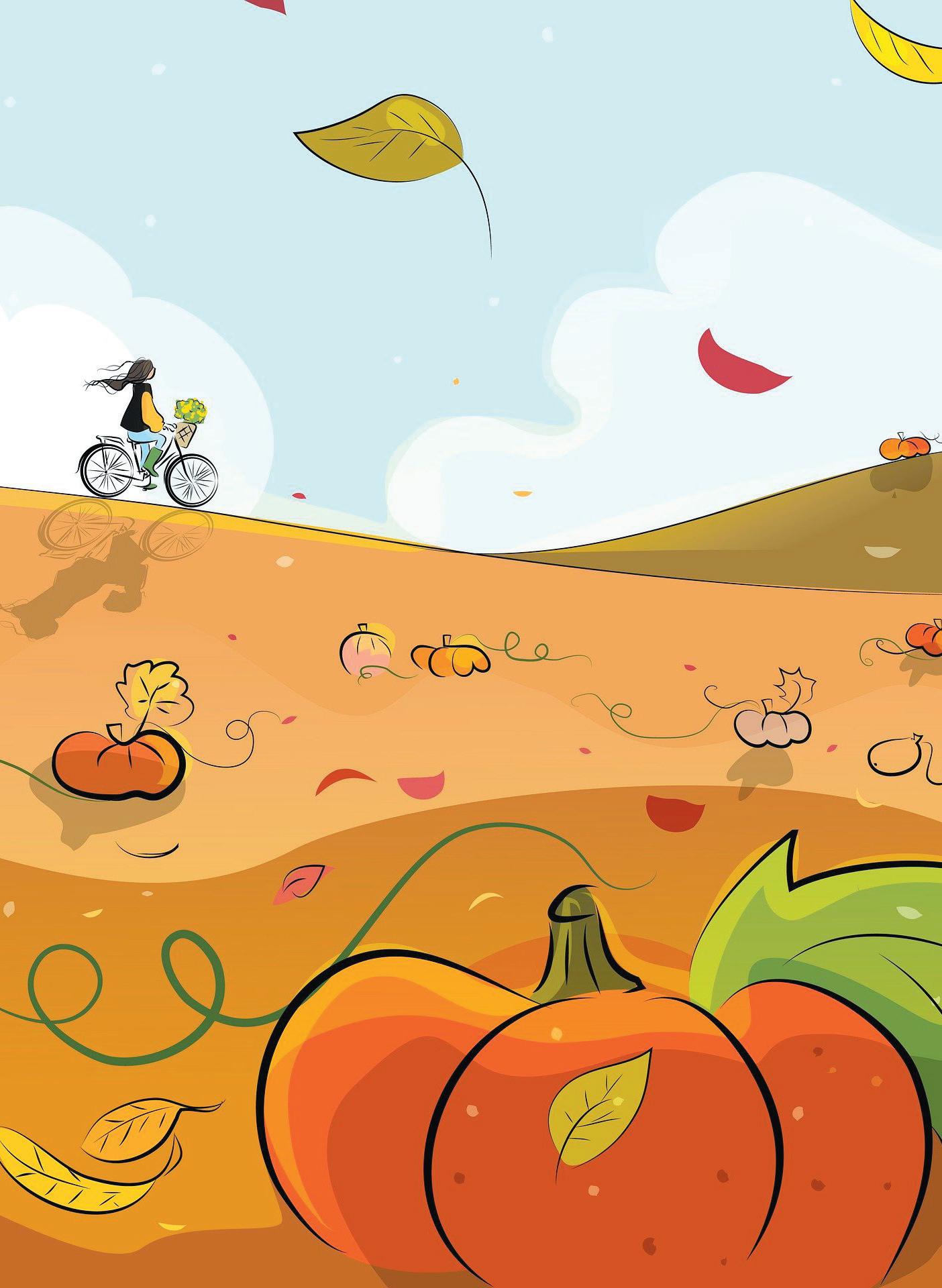

OWNER/PUBLISHER/AD SALES Victoria Ledden | 705-429-0761 | vledden1@gmail.com
PHOTOGRAPHER/WRITER Don Beaulieu



JOHN ARMSTRONG, Sales Representative john@armstrongs4u.com Cell: 705-351-2767
Collingwood Office: 330 First Street Collingwood and THE ARMSTRONG TEAM!
Brenda - Cell: 705-828-4571
Candy - Cell: 705-817-1007
Wasaga Beach Office: 1249 Mosley St. Wasaga Beach



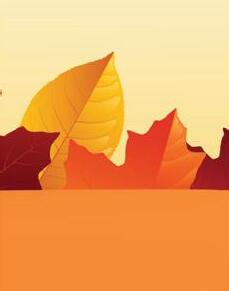













John and Nickel (his unlicensed assistant)



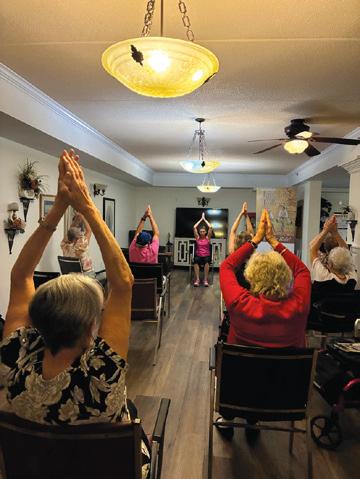



Monarchs & Milkweed
A Vital Partnership for Our Ecosystem

The monarch butterfly is one of the most recognizable and beloved insects in North America, known for its striking orange wings and incredible migration journey that spans thousands of kilometers. Yet, behind their beauty lies an essential relationship that highlights the delicate balance of nature: monarchs and milkweed.
Milkweed is the only plant where monarch butterflies lay their eggs and the exclusive food source for their caterpillars. Without milkweed, monarch populations simply cannot survive. Unfortunately, urban development, agricultural practices, and the widespread use of herbicides have drastically reduced milkweed habitats, contributing to steep declines in monarch numbers.
Why does this matter? Monarchs are important pollinators. As they travel between flowers for nectar, they help sustain biodiversity and healthy ecosystems. Their presence supports the plants that provide food and shelter for countless other species, creating a ripple effect throughout nature.



































Protecting milkweed is, therefore, an essential step in protecting monarchs. Planting native milkweed in gardens, along roadsides, or in community green spaces provides critical breeding grounds and feeding stations. Best is to create some milkweed corridors, continuous lines of milkweed plants established along monarch butterfly migration routes. Beyond milkweed, monarchs also rely on nectar-rich flowers during migration, making pollinator-friendly gardens invaluable for their survival.





If you already have milkweed in your garden, now is the time to collect the seeds from the cones, let them dry for 2 weeks, store them in your fridge and offer some to your friends to be planted next spring. (I collected thousands of seeds this week).


By supporting monarchs and milkweed, we’re also supporting biodiversity, healthier ecosystems, and climate resilience. Every milkweed plant added to the landscape is a small but powerful act of conservation.







The next time you see a monarch flutter by, remember that its journey depends on a humble plant—and that we all have a role to play in ensuring this remarkable partnership continues to thrive.
Submitted by Gerard Dusastre
Fire Prevention Tips
(NC) As temperatures drop and we spend more time indoors, it’s a good time to give your home a fire safety check. Fall and winter bring added risks like candles, cooking and twinkling holiday lights. But with a few simple precautions, you can help protect your home and the people in it.
FIRE SAFETY STARTS WITH PREVENTION
• Keep a close eye when you’re cooking. Most house fires start in the kitchen, so don’t leave the stove unattended, and keep anything flammable, like tea towels or packaging, away from heat. Clean out the dryer lint trap every time you use it.
• If you use a fireplace or a wood stove, book a chimney cleaning and inspection every fall before heating season. Stick to safe-burning materials like seasoned wood and never toss in cardboard or household garbage.
• Tidy up the space around your home: keep firewood and dry leaves away from the house, and ensure your barbeque is clean and grease-free, even in the off season.
• Replace any damaged strings of holiday lights before decorating and be sure to turn them off before leaving the house or going to bed.

MAKE SURE YOUR ALARMS AND TOOLS ARE READY
• Test your smoke alarms once a month to make sure they’re working properly. You should have one in every bedroom, outside each sleeping area and on every level of your home.
• Once a year, be sure to replace batteries in smoke alarms not wired into the home and check the expiration date on the alarm. Expired units should be replaced.
• If you have gas appliances or a wood-burning fireplace, consider adding a carbon monoxide detector too. It’s an extra layer of safety you’ll be glad to have.
• Read your fire extinguisher’s instructions carefully and keep it in a place that’s easy to reach and close to an exit.
PLAN AND PRACTISE YOUR ESCAPE
• If the worst happens and you experience a fire in your home, make sure you have a plan in place for a safe escape. Your home escape plan should meet the needs of everyone in your household, including young kids, older adults and anyone with mobility or sensory needs.
• Know two ways out of every room if possible, and make sure doors and windows open easily. Consider a window ladder for second floor bedrooms—they’re portable and can be easily stored in case of emergencies.
• Have an outside meeting place a safe distance from your home where everyone should meet.
• Practise your home fire drill at least twice a year with everyone in the household. Make sure any guests are aware of your fire plan.
A few small steps now can make a big difference in an emergency. For more fire safety tips, visit cooperators.ca.

















Master Gardener’s Corner
October
• After a warm, no, it was a HOT summer, plus some lovely summer days in September, FALL is definitely here with the possibility of early FROST one of these nights!
• There is much talk among gardeners in the fall about “Putting Your Garden to Bed”. I think they mean preparing your garden for the winter. There is an annual argument among gardeners as to whether you should cut back all your perennials, ornamental grasses, etc., and clean up all the leaves in the fall, or leave them tall for “winter interest”, or to feed the birds and make homes for the Pollinator insects. However, up here, most perennials are covered by 2 to 3 feet of snow, so you can’t see them anyway and there are very few seedheads for the birds. And finally, if left unattended in the fall, Spring Clean-Up can be daunting. There may be wet weather, cold or a late spring. For these reasons, I am opting for a BIG FALL CLEAN-UP again this year, leaving just the leaves on the beds this fall. This will give me a jump on next spring.
• It is time to trim back perennials and divide them as needed if your garden is crowded. Give them to your neighbours. Or, pot them up now and put the pot back in the ground, saving them for the St. George’s church 2026 Giant Plant Sale, in Clarksburg. It’s planned for a Saturday morning in late May or early June 2026. I will keep you posted. When you donate 15 or more perennials next year, you will receive an Income Tax receipt from the Church for the value your plants sell for. When digging and potting up this fall, always make sure to pick a cool, cloudy day and add bone meal fertilizer to the pots, or to any new plantings this fall.
• Remember, October is a great time to plant new shrubs and perennials. They get a big jump on plants you might plant next spring.
• Buy and plant spring flowering bulbs NOW. Add a little bulb fertilizer, like bone meal, to the bottom of the hole and add water to the hole to get the bulb’s roots started. Your efforts NOW, will bring big dividends in April and May 2026.
• For a longer bulb blooming season, plant a variety of bulbs, each with a different bloom date. Plant winter aconite first, then snow drops and crocus to start the season early. You can also plant early, middle and late blooming tulips and daffs in the same bed for a much longer bloom season.
• If you have squirrels or other rodents, place chicken wire just under the surface of the soil over any bulbs you plant. The squirrels will hate you, but your bulbs will love you. Interestingly, Daffs should not need this protection.
• If there is an early frost warning this fall, cover tender annuals overnight with an old bed sheet. They should make it through the night and keep on blooming.
• Bring in house plants when the evenings start to cool down, or if you get a frost warning. First, give them a thorough spray with insecticidal soap, so that there are no unwanted hitchhikers coming into your home.
• Lawn fertilizers come with a 3-number code on the bag, establishing the percentage of each of Nitrogen (for rapid growth), Phosphorus (for strong roots), and Potassium (for overall health). In the fall you want a lawn fertilizer with a low first number and high second and third numbers, or stuff advertised as a “Fall Formula” fertilizer. Don’t use that fertilizer you have left over from the spring with a high first number. There’s too much nitrogen!
• Start cutting your grass much lower than in summer to avoid winter-matted long grass next spring that you will have to rake out of your lawn.

Water shrubs, evergreens and trees weekly and deeply at least until frost comes.



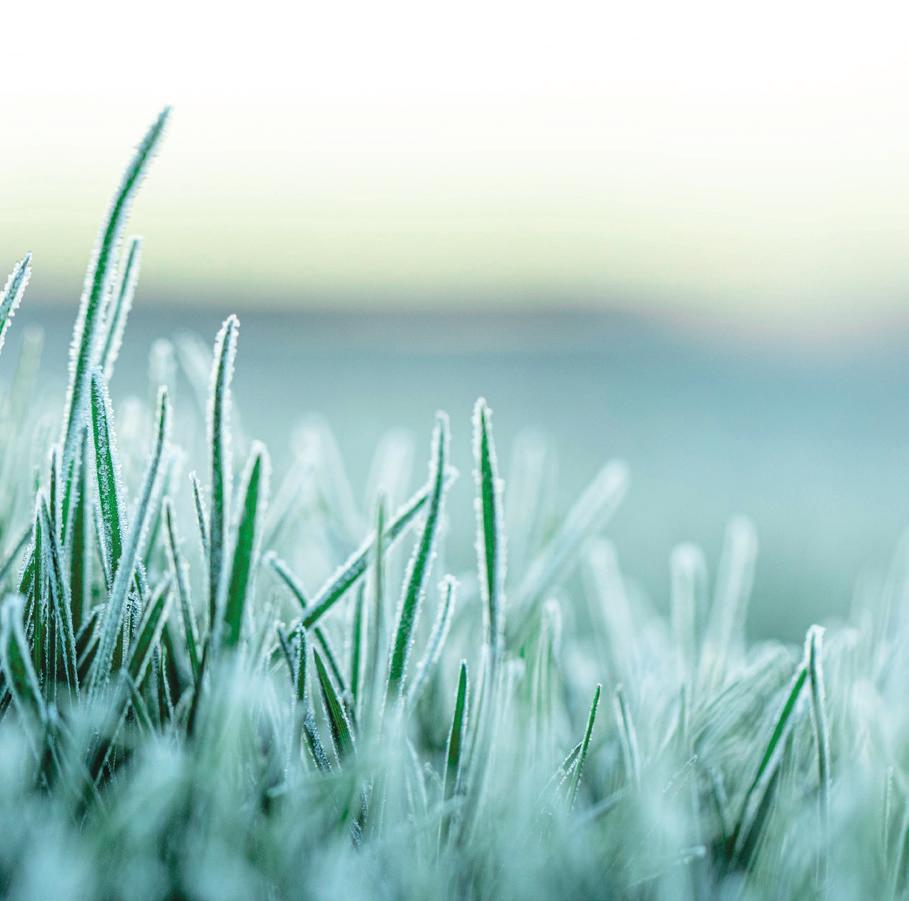


Things to do in your garden each month taken from the Ontario Master Gardener Calendar by John Hethrington, Past President, Master Gardeners of Ontario. For more information, or your copy of the 11” x 17” calendar of the full year’s tips for a $2 contribution to Master Gardeners, call 519-599-5846.
Submitted by John Hetherington

Heart-Healthy Fall Harvest Lasagna
(NC) Harvest season in Canada brings savoury favourites and an abundance of fresh produce that’s both healthy and full on flavour. Take advantage of those in-season offerings with a new take on a fall classic:
Sweet Potato and Crisped Kale Lasagna
with Apple and Sausage
Prep time: 50 minutes Cook time: 55 minutes Makes: 8 servings
INGREDIENTS
2 large sweet potatoes, washed and scrubbed
2 medium onions, diced
2 Granny Smith apple
1 bunch kale, washed, stripped and torn up (about 4 cups, or 1 L)
5 Italian sausages (500 g), mild or hot
560 g ricotta cheese
1 cup (250 ml) grated parmesan
2 tbsp (30 ml) canola oil, divided 1/4 tsp (1 ml) ground nutmeg
4 cloves of garlic, minced
1 tsp (5 ml) dried sage
½ tsp (2 ml) black pepper canola cooking spray

DIRECTIONS
Lasagna Mixture
1. Preheat oven to 400°F (200°C).
2. Pierce one sweet potato with a fork on all sides. Microwave on high until fork-tender, about 8 minutes. Let cool, remove skin, add to a large bowl and mash.
3. Add ricotta and nutmeg to the mash and mix thoroughly. Set aside.
4. In a large pan over medium-high heat, add 1 tbsp (15 ml) canola oil. Add onion and sauté for 5-7 minutes, until soft. Add garlic and dried sage, cooking for another 1-2 minutes.
5. Remove casing from sausages and crumble into pan. Cook with onion mixture for 10-12 minutes, or until cooked through. Add 2 cups (500 ml) of kale and wilt, about 1 minute.
6. Remove from heat and set aside.
7. Using a mandolin, slice the other sweet potato lengthwise. Slices should be about 1/8” (3 mm) thick. Set aside.
8. Quarter the apples and remove cores. Using the mandolin, slice quarters thinly, about 1/8” (3 mm) thick. Set aside.
Assembly and Baking
1. Spray a 9 x 13” (23 x 33 cm) baking dish with canola cooking spray.
2. Line the bottom of the dish with half the sweet potato slices.
3. Top slices with half the ricotta mixture. Spread evenly using a rubber spatula.
4. Top ricotta mixture with half the apple slices, in an even layer.
5. Spread half the sausage mixture over top and sprinkle with half the parmesan.
6. Repeat steps 2 to 4 with remaining ingredients.
7. In a small bowl, toss remaining kale with 1 tbsp (15 ml) canola oil. Distribute evenly on top of lasagna.
8. Cover with tin foil and bake for 40 minutes. Remove foil and return to oven for 10-15 minutes, or until kale leaves are browned.
9. Let cool before serving.
Tip: Using canola oil lets you take advantage of its high smoke point to really crisp up the edges of the lasagna for contrast with the tender inside layers. You can find more heart-healthy recipes that celebrate what Canada has to offer at hellocanola.ca.










Blues in the Beach




Twenty-one bands took to the stage at this year’s Stonebridge Wasaga Beach Blues, the 13th edition! Backed by an experienced and dedicated team, Artistic Director and Production Manager Gabor Szepesi presented top talent from the province and beyond. Local acts, new acts and those that brought nostalgia were all here. The two side-by-side stages kept the musical action happening with just a few minutes between acts. Somehow, the festival crew once again summoned the best weather.
The first act on day-one of the three-day event was local blues legend Lisa Hutchinson and her band. A standing ovation was had. Other bands that evening voiced their enjoyment of Lisa and her crew; it was certainly a grand beginning to a grand weekend of music.
The rest of the day presented the crowd with musical memories via Pukka Orchestra, The Zep Show (Led Zeppelin tribute band) and Blushing Brides (Rolling Stones tribute band). This was the first year for the festival to present tribute bands and what a hit they were!
The second day got off to a marvellous start with two young bands under the musical tutelage of local musician Shane Cloutier. First to hit the stage was Rock, Paper, Scissors. The youngest performer was 10 year-old Rosa Whittley playing bass guitar. They were followed by another band of students Eyes of Violet. We had a band from Ormstown, Quebec wrap up the second day of music; the Durham County Poets.
A variety of blues, rock and soul-based bands filled out the bill, including a trio from Ireland, Delta Fuse. Ontario’s bluesman Johnny Max found this band in a pub in Ireland and insisted they come to Canada to play. This festival was their last stop on their Canadian tour.
The largest ensemble to hit the Stonebridge Wasaga Beach Blues stage was The Commotions from Ottawa. They were a ten-piece unit here. At “home”, they are a 12-piece. Soul Stew wrapped up the festival with blues, funk, soul, reggae and medleys, keeping the energy going right to the last beat.
Keep your eyes peeled for notices of next year’s Stonebridge Wasaga Beach Blues. It just may be the best organized, friendliest, music-loving festival around.





The Zep Show
The Blushing Brides
Rock, Paper, Scissors
Angelica Jones
Rosie’s Smokehouse Deluxe
Glenn Marais + The Mojo Train
Cheryl Lescom + The Tucson Choir Boys
JW Jones
The Commotions
Submitted by Don Beaulieu
Mould: The Uninvited Intruder
Mould is a major problem when it shows up in your home. How to stop this uninvited intruder and get rid of it? It is very important to deal with this issue as soon as you notice any mould on any surfaces in your home as it regenerates and spreads quickly. Mould spores travel throughout air, attach themselves on any damp surfaces and then begin spreading through the materials as it grows.
It is vital to stop the spread and get rid of mould. It can cause allergic reactions and respiratory problems just to mention a couple of health related issues. First you have to eliminate the source that causes moisture to let mould grow/ spread.
ELIMINATE
MOISTURE
• Find and fix the leak(s).
• Improve ventilation. Kitchen and bathroom need proper airflow.
• Control humidity: use a dehumidifier to lower humidity level, first of all in basements.
The most common areas mould likes to build -up:
• Window sills
• Shower/bathtub, grout, caulking, corners, shower curtains
• Washing machine front loader gasket
• Leaking pipe
KILL EXISTING MOULD
Different cleaning solutions are very effective to kill mould; however they do not prevent regrowth without addressing the underlying moisture problem.
Walls
Borax is a natural mould retardant.
• If you live on an area where the humidity is high, try adding a cupful to your soapy water whenever you decide to wash down your walls.
• Add a mixture of 1/2 cup borax and 1/2 cup white vinegar to 1 cup of water.
• Pour the solution into a spray bottle and spray generously on the mouldy surfaces. Wipe the walls clean with a damp clean cloth.
White vinegar is a great mould eliminator, too.
• Use undiluted vinegar.
• It penetrates porous surfaces and kills mould at the root. It is safe and beneficial to leave vinegar on mouldy surfaces as it penetrates deeper and kills more mould spores.
Bathrooms
Hydrogen Peroxide
• To fight mould in bathrooms use 30 or 35 % hydrogen peroxide with equal amount of water. Spray it on, wait an hour and spray it again.
• No rinsing is necessary. If mould remains, spray it again in 2 days.
• Do not use hydrogen peroxide on coloured grout! Vinegar
• Make a solution of 3 tablespoons of white vinegar, 1 teaspoon borax and 2 cups of hot water in a clean spray bottle.
• Shake it well.
• Then spray the mixture on painted surfaces, tiles, windows, etc...Wherever you find mould.
• Use a soft scrub brush to work the solution into the stains or just let it soak in.
PREVENTION
• Address moisture issues:
• First of all eliminate moisture that allows mould to grow
• Keep surfaces clean and dry daily
• Monitor humidity: Use a dehumidifier to keep proper humidity level in damp areas in your home.
SAFETY
• Wear proper goggles to protect your eyes if you decide to use harsh chemicals!
• Have proper ventilation during and after cleaning!
Call a professional if the mould growth is beyond your cleaning.
Edit Baker Greencleanercanada 519-938-1702 grcleaner@gmail.com
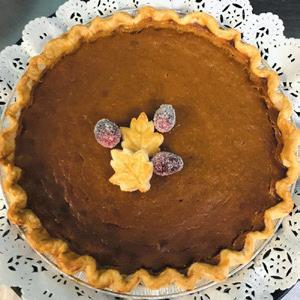













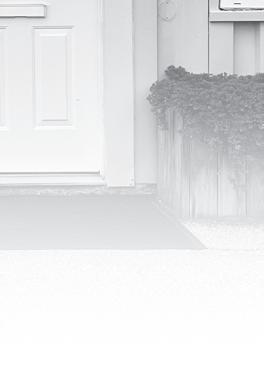





Savoury and Satisfying
(Family Features) Savoury and satisfying, comforting ingredients can transform simple recipes into mouthwatering meals. As temperatures fall, people look for comforting foods to warm the soul.

MEDITERRANEAN LAMB MEATBALLS AND PEARL COUSCOUS
Dinner can be ready in the snap of a finger with Mediterranean Lamb Meatballs and Pearl Couscous where savoury ground lamb takes centre stage. This tempting dish highlights tender pearl couscous, sauteed veggies and briny feta cheese coming together in half an hour so you can spend more time at the table and less time in the kitchen.
Servings 4
Prep Time 20 mins
Cook Time 10 mins
INGREDIENTS
2 cups pearl couscous
4 cups chicken broth
1 pound ground lamb
2 eggs
1 1/2 cups feta cheese crumbled, divided
3/4 cups panko breadcrumbs
2 tablespoons Greek seasoning
1 teaspoon salt
2 tablespoons olive oil divided
1/4 cup onion chopped
1/4 cup mushrooms sliced
1/4 cup zucchini diced
1 cup tzatziki
2 tablespoons fresh mint chopped (optional)
INSTRUCTIONS
1. Prepare pearl couscous according to package directions. Replace water with chicken broth.
2. In large bowl, combine lamb, eggs, 3/4 cup feta, panko breadcrumbs, Greek seasoning and salt. Knead gently to combine. Form small meatballs using hands.
3. In large pan over medium heat, heat 1 tablespoon oil. Cook meatballs 5 minutes until browned on all sides. Reduce heat to medium-low and cover pan with lid. Cook 5 minutes, or until fully cooked.
4. In medium saucepan over medium-high heat, heat remaining oil. Add onions and cook 2 minutes. Add mushrooms and zucchini and cook 3 minutes. Stir in pearl couscous until ingredients are fully combined.
5. Divide pearl couscous between bowls. Add meatballs then tzatziki. Garnish with remaining feta and mint, if desired.
Habitat for Humanity
At a time when housing costs continue to rise and families struggle to find safe, stable places to live, Habitat for Humanity Huronia is working hard to be part of the solution. For over 30 years, Habitat Huronia has partnered with local families, volunteers, and businesses to build affordable homes right here in our community. Habitat is not a giveaway program.
Families who partner with us invest hundreds of hours of volunteer time —working alongside other volunteers to help build their own homes or the homes of others. Once construction is complete, families purchase their home through an affordable mortgage geared to their income. This unique model helps break the cycle of poverty, builds stability, and creates a foundation for stronger futures.
The impact of affordable homeownership ripples outward. Studies show that children in stable housing do better in school, families experience improved health and well-being, and communities benefit from stronger engagement and economic growth. At Habitat Huronia, we have seen first-hand how a safe, affordable home can transform lives.
Our ReStores in Barrie, Alliston, and Collingwood are another important part of this mission. These nonprofit home improvement outlets sell gently used furniture, appliances, housewares, lighting and building materials, keeping thousands of pounds of waste out of landfills each year. By shopping, donating, or volunteering at a ReStore, community members make a direct contribution to building affordable housing.
But the need continues to grow. We cannot build homes without the support of our community - donors who invest in our mission, and partners who join us in the belief that everyone deserves a safe and decent place to live.
‘Habitat for Humanity Huronia brings people together to build homes, communities and hope.”
We invite you to learn more, get involved, or volunteer in our Restore. Visit www.habitathuronia.com to see how you can help. Because when families have a place to call home, communities thrive.
Submitted by Debbie Savic – Director of Fund Development




Shut Up and Listen
Your Monthly Goose Honk of Wisdom
Pull up a stump and get comfy—you’ve found your way to Shut Up and Listen. This isn’t a lecture, and it’s definitely not group therapy. No dimly lit room, no circle of chairs, no one leaning in to ask about your childhood. What do you get instead? Fresh air, a little dirt under your boots, and the occasional bird acting like it runs the place (because, honestly, it kind of does).
The whole point of this series is simple: Nature has been whispering (okay, sometimes shouting) ways to help us feel less scattered and more steady. No lineups, no fees, no awkward waiting-room magazines. Just real reminders that clarity often comes in the form of wind, leaves, or even that honking goose you secretly suspect is judging you.
Over the past few months, we’ve looked at how stepping outside isn’t just “time in nature”—it’s a reset button that helps you show up better in every other part of life. And each month, I’ll keep sharing a small trail-side takeaway from my book Shut Up and Listen—easy, practical bits you can actually use.
So whether you’re sneaking this in on your lunch break or sipping coffee by the window, stick around. This month, we’re letting the woods do the talking.
Don’t Leaf Them Hanging
Procrastination. It’s that little voice that keeps you stuck at a crossroads, scared to make the wrong move, or just too unsure to leap. So, you stall. You wait. You wonder if maybe the universe will just send you a neon sign. Guess what? It won’t. But Nature’s got your back. Consider the trees in autumn. They don’t sit there clutching their leaves like they’re the last cookies in the jar. They drop them. They let go. It’s part of the cycle.

Ask yourself this: What am I procrastinating? What’s holding me back from just doing it already?
“Don’t leaf things hanging.” It’s time to let go. The perfect moment? It doesn’t exist. The time is now—go for it, and let Nature show you how it’s done!

LET IT FALL
Find a Fallen Leaf: Head outside and look for a leaf on the ground. Pick one that stands out to you—a cool shape, a bold colour, or just the first one you see.
Inspect the Leaf: Hold it and take a good look. Notice its colour, texture, and even the little flaws. This leaf didn’t cling to the tree out of fear or indecision. When the time came, it let go, trusting the natural cycle to keep moving forward.
Write It Out: Grab a pen and list three things you’re clinging to but know it’s time to release. Maybe it’s a grudge against your coworker who stole your lunch, that decision you keep dodging, or your undying need to always be right. Write them in the left column.
Let It Go: In the right column, jot down how you’ll finally release each item from your left column list. I know letting go can feel like parting with your last slice of pizza. Free yourself by tossing that mental baggage into a cosmic dumpster with flair. And hey, press your leaf as a bookmark— it’ll be a handy little reminder next time you’re clinging to something you should’ve let go ages ago.
NATURE’S WAITING
Unlocking Nature’s wisdom is like finding the secret door to a calmer, clearer you. A little time outdoors can lower stress hormones, reduce anxiety, and even lower blood pressure. It clears out the noise, kicks stress to the curb, and gives you a confidence boost you didn’t even know you needed. And that’s exactly why this column exists. Keep tuning in each month as we crack open more of Nature’s code and start showing up as the best version of ourselves—wild bits and all.

Raven is an inspirational speaker, author, storyteller, and educator whose deep love for Nature winds through everything she creates. From guiding immersive outdoor retreats and leading down-to-earth workshops to producing story-rich albums and podcasts (available on all major platforms), her work is all about helping people unplug from the noise and reconnect with what really matters.
Her latest book, Shut Up and Listen: A No BS Guide to Unlocking Nature’s Wisdom in 31 Days, is now available at Amazon.ca and through her website at www. ravenspeaks.ca, where you’ll find everything she offers—all in one place.
Submitted by Raven Murphy

Leftover Holiday Biscuit Pot Pie
(Family Features) Once your holiday feast comes to pass, you’re almost certain to find your refrigerator stuffed with leftovers. However, that doesn’t mean you want to eat the same meal again and again in the days that follow.
The star of many seasonal celebrations, turkey can be reused in a variety of post-holiday dishes to cut down on food waste and create fresh new meals your whole family can enjoy. Featuring a unique blend of 100% natural chili peppers, lime and sea salt,
Gone are the days of simply reheating turkey and stuffing or making a turkey sandwich. Instead, reinvent your holiday extras through fresh takes on classic dishes like this comforting Leftover Holiday Biscuit Pot Pie.
Time 45 minutes
Servings 4
INGREDIENTS
Biscuits:
1 1/2 cups all-purpose flour
2 teaspoons baking powder
2 1/2 teaspoons sugar
1/4 teaspoon salt
2 teaspoons cream of tartar
1/2 cup cold unsalted butter
2/3 cup buttermilk
1 tablespoon butter melted
Turkey Pot Pie Filling:
1/2 cup turkey fat
1 1/2 cups diced onion
1 1/2 cups diced carrots
1 1/2 cups diced celery
1 bay leaf
1 tablespoon minced garlic
1 tablespoon chopped thyme
1 tablespoon diamond crystal coarse salt
1 tablespoon coarse black pepper
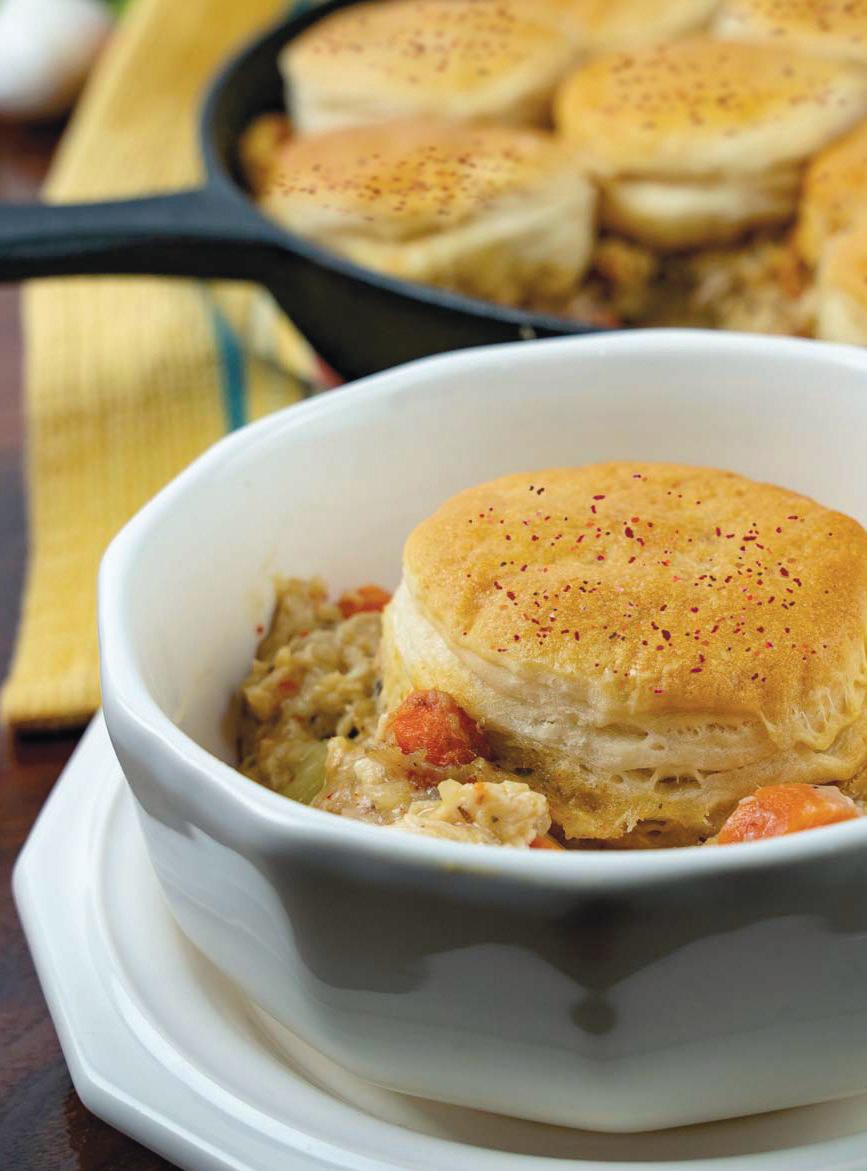
1 cup all-purpose flour divided
8 cups cold turkey stock
Tajín Clasico Seasoning to taste (about 1 tablespoon)
6 cups leftover cooked turkey chopped
DIRECTIONS
To make biscuits:
1. In mixing bowl, combine flour, baking powder, sugar, salt and cream of tartar.
2. Grate butter and mix with dry ingredients.
3. Carefully add buttermilk and mix until incorporated.
4. Fold over 5-6 times, roll out and cut into 10-12 rounds.
5. Place cut biscuits on floured surface.
6. Refrigerate 30 minutes.
To make turkey pot pie filling:
1. Preheat oven to 375 F.
2. Heat large pot over high heat and add turkey fat.
3. Add onions, carrots, celery, bay leaf, garlic, thyme, salt and pepper; gently sweat.
4. Add 1/2 cup flour and cook 2-3 minutes.
5. Add turkey stock 2 cups at a time, allowing to thicken before adding more.
6. In bowl, mix remaining flour with turkey.
7. Add turkey pot, bring to simmer until thickened.
8. Add seasoning, to taste.
9. Add pot pie filling to casserole dish and gently place biscuits closely together on top.
10. Brush biscuits with melted butter and bake 25-30 minutes.
11. Remove from oven and cool 10-15 minutes before serving.


1470 Mosley St., Unit 5, Wasaga Beach 705-429-9382 info@georgiangraniteworks.ca georgiangraniteworks.ca
to 1:00pm
















Frieda Linke - Local Artist + Teacher Portraits in pencil, pastel and paint.

Mind. Body. Spirit.
Five Ways to Prioritize Self-Care
(BPT) - Autumn is often accompanied by packed schedules filled with back to school, family gatherings and days outdoors, making it easy to let wellness habits slip.
However, prioritizing self-care can make a big difference in how you feel and function so you can fully enjoy everything on your sunshinefilled schedule all season long. To help you out, Registered Dietitian and Nutritionist Dawn Jackson Blatner offers the following pro tips.
1. REFRESH YOUR SPACE
When life feels chaotic, a cluttered space can make it worse. But you don’t have to overhaul everything. Start small! Pick one spot each week to tidy, like your car, work bag or fridge.
As part of the refresh, Blatner suggests adding something small to your daily spaces that sparks joy. It could be colour, music or a meaningful item that reminds you to take care of yourself, even during the busiest days.

2. UNPLUG
It can be easy to mindlessly scroll on your phone or other devices. You don’t have to give up your electronics, but setting digital boundaries can help reduce your screen time. Schedule time in your day for screen-free outdoor time to reduce stress and soak up mood-boosting vitamin D.
3. EAT WHAT MAKES
YOU FEEL GOOD
Focus on eating foods that taste good and make you feel nourished and happy. Blatner recommends keeping a feel-good fridge zone with pre-chopped veggies, hard-boiled eggs for grab-and-go protein, antioxidant-packed snacks like seasonal berries and infused water jars with herbs and citrus.
4. MAKE MOVEMENT FUN
Does the thought of hitting the gym or going on a run fill you with dread? Don’t force yourself to do an exercise you don’t enjoy. Instead of traditional workouts, embrace playful movement outdoors like paddleboarding, bike riding, beach volleyball or even dance classes to keep fitness fun and consistent.
5. MAKE A SWEET, PROTEIN-PACKED SNACK
Satisfy your sweet tooth with a homemade treat made from high-quality ingredients like Blatner’s recipe for Protein Cookie Bites. They’re a deliciously crave-worthy yet nourishing snack to tackle those sweet cravings throughout your day.
Protein Cookie Bites
Prep time: 10 minutes Cook time: 8 minutes Yield: 24

INGREDIENTS
2 large eggs
1/2 cup natural peanut butter
4 tablespoons maple syrup
1/2 cup vanilla protein powder
1/2 cup rolled oats
1/4 cup dark chocolate chips
1/4 teaspoon sea salt
DIRECTIONS
1. Preheat oven to 350 degrees F.
2. In a medium bowl, whisk eggs and stir in peanut butter and maple syrup.
3. Add in protein powder and oats and stir until fully mixed. Then, fold in chocolate chips.
4. Scoop the batter into 24 mounds on a parchment-lined baking sheet and top each with a pinch of salt.
5. Bake about 8 minutes or until bottoms are golden. Let cool for 15 minutes and enjoy.
Storage: Store in an airtight container at room temperature for up to three days, in the fridge for up to seven days, or freeze for up to three months.
Don’t forget to take care of yourself no matter how busy you get! Using these five pro tips, you’ll be able to prioritize self-care, even with a packed schedule.

ADHD: Children and Teens
ADHD, or Attention-Deficit/Hyperactivity Disorder, significantly impacts children and teens in various ways, as described below.
Children with ADHD often struggle to focus on tasks, leading to challenges in school and at home. They may find it hard to complete homework or follow multi-step instructions. This can cause stress for the child or teen with ADHD and can affect the youth’s ability to deal with extra stress or anxiety. Without effective coping skills, children and teens struggle significantly.
Many children exhibit excessive movement, such as talking excessively, fidgeting or difficulty remaining seated in calm settings. This can disrupt social interactions and classroom environments. Another aspect of ADHD can include Impulsive behaviours. Interrupting conversations or acting without thinking, can lead to social difficulties and challenges in developing relationships with peers. This can also impact the youth’s self esteem and self image.
Another aspect of ADHD that can be challenging is their difficulty in managing their emotions. They may experience intense frustration, anger, or disappointment, making it challenging to cope with stress or setbacks. Sometimes these intense emotions can cause a youth to develop excessive worry or anxiety.

It is clear the combination of attention difficulties, hyperactivity, and impulsivity can lead to underachievement in school. These children may perform below their academic potential despite having average or above-average intelligence. In many children and teens with ADHD, other mental health challenges may develop. Issues such as anxiety, depression, or learning disabilities, can aggravate or compound the youth’s difficulties. As mentioned before, many youth experience poor self esteem and self worth which affects the youth’s ability to be successful at school developing relationships and feel positive about themselves.
Another important factor is to consider the effects of ADHD on the youth’s family. Dealing with ADHD is a family affair for sure. Issues associated with ADHD can strain family relationships, as parents and siblings try to learn effective ways to help the child with ADHD.
Overall, ADHD can affect various aspects of a child’s life, impacting their educational performance, social relationships, and emotional well-being. Remember knowledge is power. As a parent of a child with ADHD, it is essential that you connect with the resources readily available to you. Once again, if you are observing your child or teen struggling, reach out for counselling or parenting support. Early intervention and support can significantly help manage symptoms and improve outcomes for the youth and their families.
Some of the resources available are:
CADDAC – Centre for ADHD awareness – https://caddac.ca
ADHD Embrace – http://adhdembrace.org – UK resource
WebMD – webmd.com/add-adhd,com – US resource
Wendy Hunter, Registered Psychotherapist
In Support Of Children Counselling















Harvests of Gratitude
Ancient Fields to North American Thanksgiving
The oldest festivities recognizing what we would refer to as Thanksgiving revealed, by archæology, go back to Neolithic harvest rituals. This means 10,000–5,000 BCE (Before Common Era). This is connected to the rise of agriculture in the Fertile Crescent, where people began seasonal harvest festivals.
The Fertile Crescent occupies parts of Iraq (the core of ancient Mesopotamia, between the Tigris and Euphrates Rivers), Syria, Lebanon, Israel, Palestine, Jordan, Kuwait (sometimes included at the southeastern end), Egypt (Sinai and Nile Delta are often linked with it, although some maps exclude Egypt), Turkey (southeastern part, near the headwaters of the Tigris and Euphrates Rivers), Iran (western edge, especially near Mesopotamian lowlands). This area is also referred as the cradle of humanity. Archæological evidence at sites like Çatalhöyük (Turkey) shows communal feasting tied to the agricultural cycle. While it was not the popular Thanksgiving we know, these events served the same basic purpose: giving thanks for food security. Many of us today consider thanks for other good fortunes and health, as most of today’s population today is not directly connected to agriculture and direct harvesting of food.
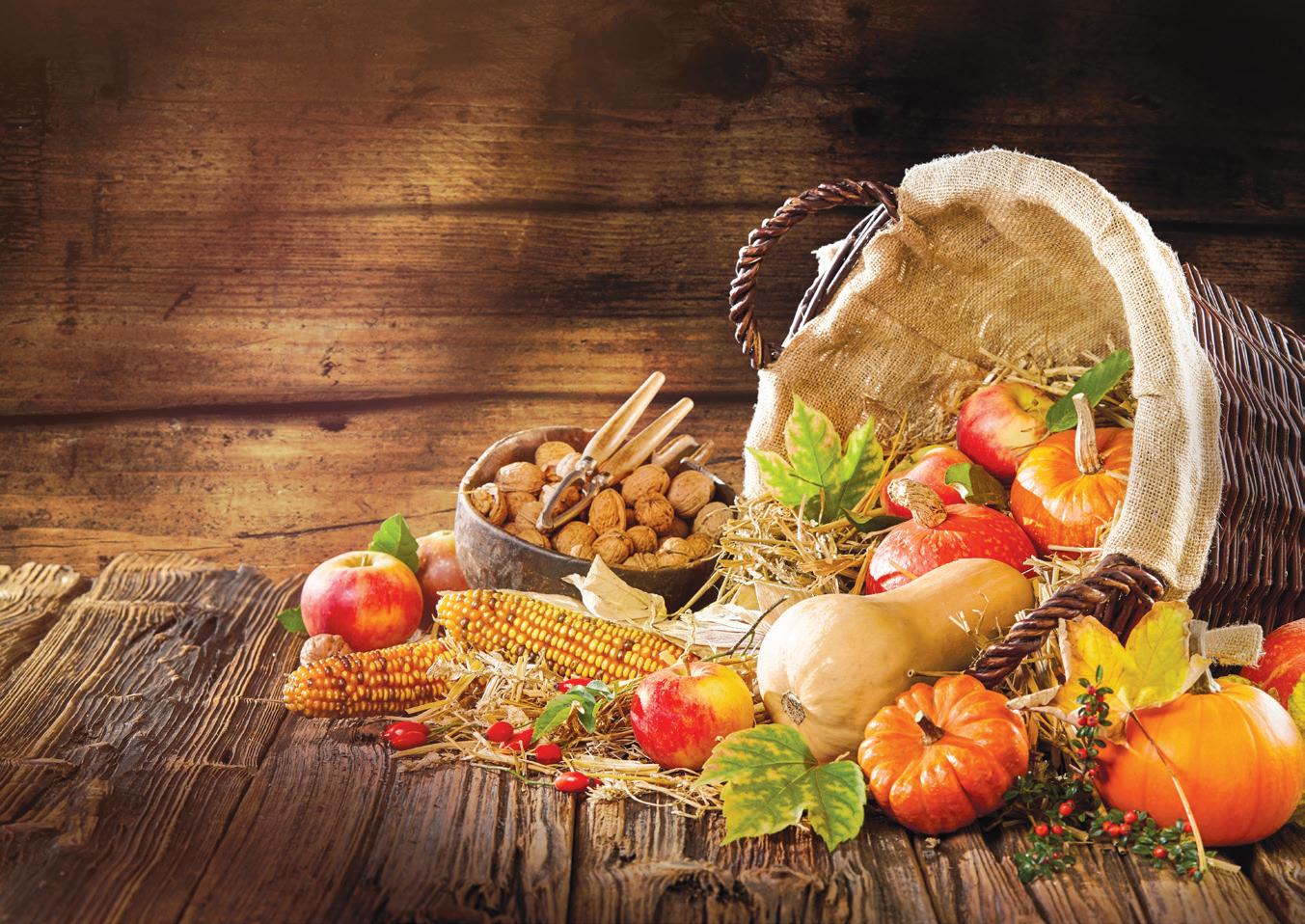
Circa 3000 BCE, there is evidence of Egyptians celebrating the annual flooding of the Nile River. This flooding guaranteed fertile soil and abundant crops. Offerings were made to Osiris (the Egyptian god of afterlife, death, resurrection, fertility and oft-associated with agriculture); communities feasted in gratitude for the harvest.
In Greece, it was around 1000 BCE that Demeter’s Festivals began. Demeter was their goddess of grain. Festivities included rituals, sacrifices and communal meals; essentially a harvest thanksgiving.
Romans began honouring Ceres, their goddess of agriculture, with festivals tied to agriculture as early as the early 5th century BCE, and autumn harvest rituals to her likely developed alongside spring festivals soon after. These festivities included games, music and feasting; closer in spirit to our modern Thanksgiving.
Long before European contact, many indigenous North Americans held harvest ceremonies.
The Haudenosaunee (Iroquois) gave thanks with multiple festivals through the year, including a Green Corn Festival in late summer.

The Wampanoag had long-standing ceremonies of gratitude for successful crops and hunts.
Indigenous peoples of the Great Plains partook in rituals such as the First Fruits ceremonies which involved thanking the Creator and spirits for sustenance.
Vikings made it to the shores of North America around the year 1000. They didn’t have a single holiday called Thanksgiving. The Norse/Vikings had autumn harvest rituals and feasts of gratitude with offerings, toasts, and big communal meals which all echo the same themes.
As for post-Columbian (Christopher Columbus) celebrations in North America, Florida saw some of their earliest thanksgiving-like events on the continent. In Florida (1565) Spanish settlers at St. Augustine held a Mass of thanksgiving with Indigenous Timucua people decades before the famed Plymouth/Pilgrims stories took place.
In Newfoundland (1578), English explorer Martin Frobisher held a thanksgiving service after surviving harsh voyages.
Plymouth, Massachusetts (1621): The “First Thanksgiving” story of Pilgrims and Wampanoag sharing a three-day harvest feast is the most widely remembered, but it was part of a much older human pattern.
It is easy to grasp the relationship of thanksgiving being related to the first agricultural societies, where people held harvest rituals of gratitude. In North America, Indigenous ceremonies of thanks predate colonial thanksgivings by millennia.
While our modern Thanksgiving certainly has specific cultural roots, the act of communal gratitude for food and harvest is as old as farming itself.
Submitted by Don Beaulieu
BLUE MOUNTAIN AUTUMN
The Mountain isn’t blue at all
On this gorgeous Autumn day It’s a riot of blazing colour
Like an artist’s palette gay
We drive out through the sugar bush Where the air’s like vintage wine
Where the brilliant, scarlet maples Seem to glow in the sunshine
The oaks are much more sombre With their many shades of brown They add respectability
To the boulevards of our town
The golden glow of poplar Paler yellow of the birch
All make our Mountain beautiful ‘Ere they leave us in the lurch
The sun-glow on the Mountain Shines like fire on perfect gems
It’s a transcendental vision
To inspire the hearts of men
It’s a blaze of Autumn glory
Before Winter, white and sere
A fitting ending, in my mind
To another passing year
Robert G. Adams - October, 1977
A FAR AWAY PLACE
He boards the shuttle, Then does a slight huddle, It is a situation he must not muddle, For his ride begins to the moon, Earth he will leave soon, He braces for the blast off, He gets respect, Not scoff, So off he goes,
As reporters let others know, The man looks out seeing space, He lived thru the arms race, Now he does brace, For a trip - to a far away place.
Ryan P. Barnett
Poetry Corner
5 Environmental Organizations
CREATING A MORE VIBRANT PLANET
(NC) Fall is a wonderful time of year to be in the outdoors, and what better way to celebrate the season than getting involved with organizations and initiatives whose mandates are focused on helping make our planet a healthier place? If you’re not sure where to start, here are five organizations that are helping improve the quality of the environment across Canada. In addition to volunteers and private donations, these organizations also rely on funding from corporations and other funders.
NATIONWIDE LAND CONSERVATION
The Nature Conservancy of Canada (NCC) is a conservation organization that aims to protect natural spaces across the country. As a private, non-profit organization, the NCC works with individuals, corporations, foundations, Indigenous communities, other non-profits and governments at all levels to protect the lands that sustain plants and wildlife. To learn more about the NCC and to volunteer, donate or attend a local event visit natureconservancy.ca.
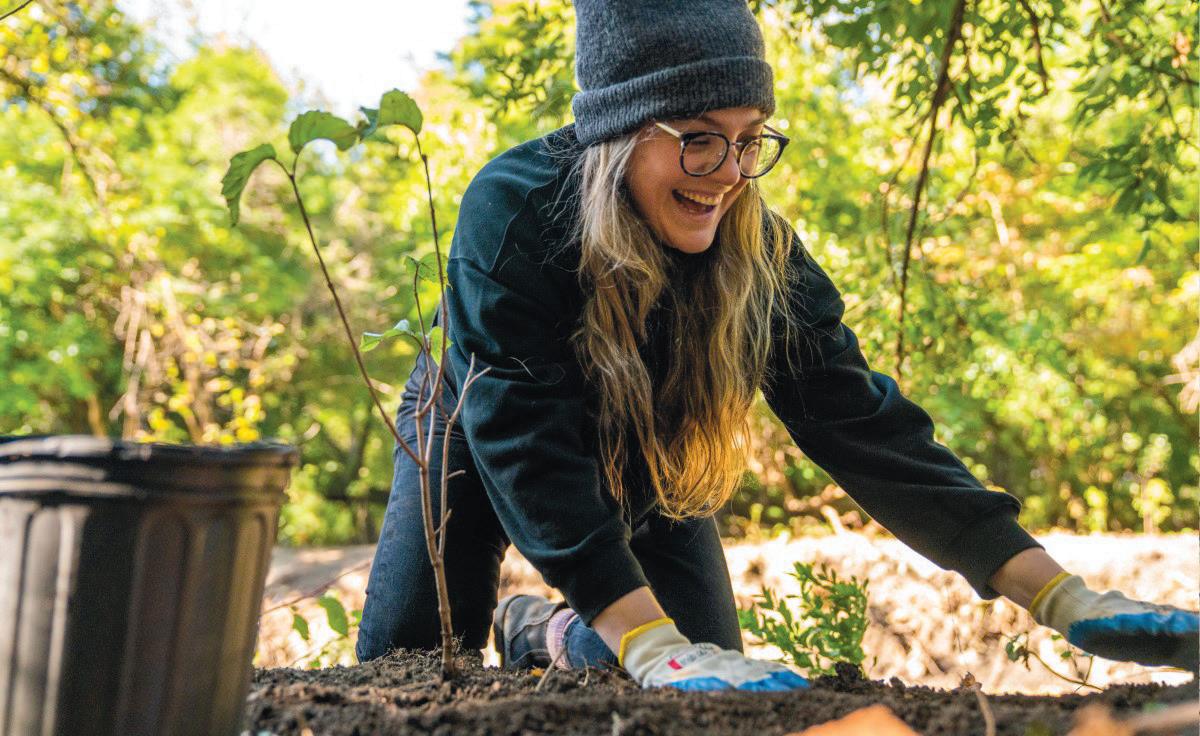

Embrace Our Bountiful Friends Lives With Acceptance Of Their Gifting’s & Talents... Uniting & Blending As One... Give Us The Courage, The Strength In Travelling Many Journeys & Adventures As Our True Family Unit... Embrace, Respect, Appreciate Our Differences As Well As Our Sameness In Life... Together We Are Truly Loved & Blessed, Treasured In Each Other’s Arms... How Beautiful Are We...
Wendy D Pogue

For people living in or visiting Toronto, the Evergreen Brick Works – a repurposed brick factory that is home to hiking trails, a garden market, educational workshops and more – offers free immersive self-guided tours. The organization says that it aims “to reveal how ecosystems and people co-exist and co-create our urban places.” For more information on their workshops and activities, visit evergreen.ca.
PRESERVING A KEY RIVER VALLEY
The Meewasin Valley Authority is a non-profit organization that describes itself as existing “to ensure a healthy and vibrant river valley, with a balance between human use and conservation, for the benefit of present and future generations” in Saskatoon and its surrounding area. For more information about what the organization is doing, visit meewasin.com.
SUPPORTING LOCAL FOODBANKS
Ecosource is an Ontario-based organization whose mandate is “to inspire communities to become more environmentally responsible through creative public education.” Ecosource runs a volunteer program from April to October to grow fresh produce for local food banks. Each session includes seasonal gardening tasks such as seeding, transplanting, harvesting, watering and moving compost.” You can find out how to get involved in these sessions and more at ecosource.ca.
TREE PLANTING
10,000 Trees for the Rouge is a volunteer-driven, non-profit group in Ontario with the goal of restoring natural habitat within the Rouge Valley, on Toronto’s eastern border. The organization hosts several planting events each year. Learn more at 10000trees.com.
Learn more at td.com/ready commitment.
Happy Halloween
AMBER APPLE CIDER
AROMAS
CARVING
CAULDRON CELEBRATION
CINNAMON COMMUNITY
COSTUME
CRANBERRIES
CRISP FALL COLOURS
FAMILY
FEAST
HALLOWEEN
HARVEST
HAUNTED LEAVES
OCTOBER TURKEY










Enjoying Screen-Free Play is Good for You
... and Your Cat
(BPT) - Getting tired of scrolling on your phone? While it may seem like a stress-reliever, constantly being glued to screens can actually increase stress.
A recent University of Texas study found that taking a break from our screens can significantly improve mood and well-being. Many of us have fond memories of childhood weekends spent playing outdoors or staying in for game nights with family and friends. Reviving these routines is a great way to unplug and get much-needed breaks from over-stimulation and stress.
If you’re seeking engaging activities beyond the screen, why not revive the cherished tradition of game night?
According to the National Institute for Play, the many benefits of play throughout your adult years include emotional, physical, social and cognitive advantages. And humans aren’t the only ones who benefit from play - if you’re a pet owner, you may already know how much our furry friends love to engage in fun activities.
“Play is a great outlet for humans and pets alike,” said Purina pet behaviourist Dr. Annie Valuska. “Enjoying activities together is one of the best ways to deepen your bond with your pets.”
GAME TIME MEETS PLAY TIME
If you have a pet at home, including them in your screen-free routines is a great way for both of you to get much-needed playtime and mental stimulation while strengthening your bond.

Friskies, the popular cat food and treat brand, recently created a brand-new game, “Adventures in Friskies World” to give board game and pet enthusiasts a fun activity that brings back the nostalgia of game night - with a feline twist.
Developed by world-class game designer Ellie Dix, with cat insights from Dr. Annie Valuska, Adventures in Friskies World gives cat fans and board game lovers a challenging adventure that will keep them on their toes. Plus, if you have a cat at home, your felines also get a special toy included in the game, so they can stay entertained with the greatest toy of all - the cardboard shipping box the game arrives in.
“Cats are often incorrectly stereotyped as aloof and reserved, but their health and development benefit tremendously from playtime with us,” said Dr. Valuska. “They enjoy variety, and they love a challenge - much like humans do - so we designed the game with their instincts in mind.”
The Adventures in Friskies World game is available for purchase at BoardGame.friskies. com, while supplies last.
DR. ANNIE’S TIPS FOR ENHANCING CAT PLAYTIME
Meanwhile, to help bring out the playful side in your cats, keep them in mind as you explore new ways to play, using tips from Dr. Annie, and even taking inspiration from the board game.
1. DISCOVER YOUR CAT’S FAVOURITE TOYS
Experiment with different toys to find out what your cat responds to the best. Cats naturally love to stalk, chase and pounce. Try out different toys that are designed for them to bat around, clutch, kick or carry, such as balls or small stuffed toys.
Safety tip: Always supervise play with toys that have feathers, strings or other parts that could be swallowed.

2. EXPLORE DIFFERENT PLAY MODES
While some cats love to catch toys and then stay put with their “prey,” others are more intrigued by toys that move or make noise. Some like to chase a toy that is fast moving, while others are intrigued by slow stalking. Changing how you play with toys can make things more interesting for your cat. It will help
you learn which styles of play your cat likes best, giving you more opportunities to enjoy spending time together.
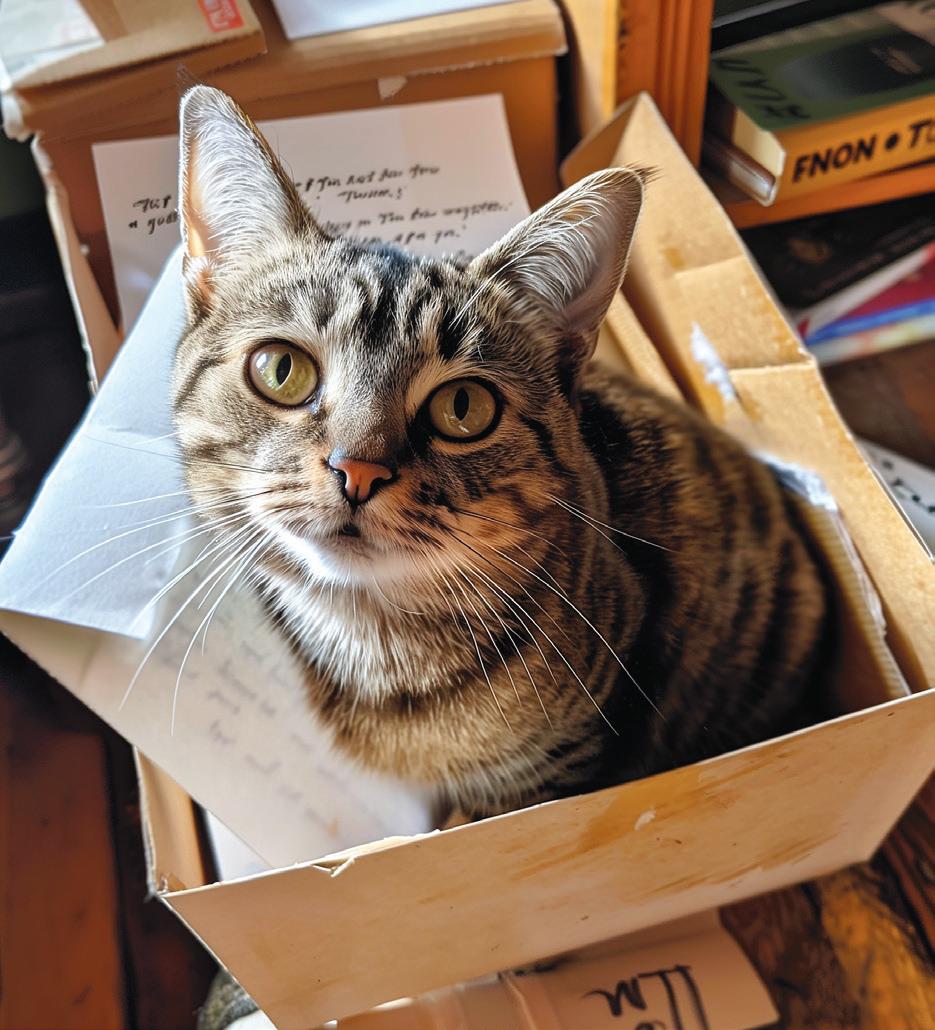
3.
BRING OUT THE BOXES
You’ve seen it happen - sometimes your cat likes the box their new toys came in better than the toys themselves! And luckily, Adventures in Friskies World comes in a box your cat will enjoy. But why do cats love boxes so much? “Cats are ambush mesopredators who love cardboard boxes because they provide a safe, enclosed space where they can hide, feel secure and observe their surroundings without being seen,” said Valuska. “On top of that, the texture of cardboard is perfect for biting and scratching, making it fun and engaging for cats to play with.”
Playing with your cat is more than just, well, cat’s play. It offers a world of exploration, physical activity, mental stimulation and fun that helps your cat stay happy and healthy. Best of all, it’s a fantastic way to enjoy screenfree fun with your furry companion.
Learn more about all the tasty options to tempt your feline family member at Friskies.com.
FALL WHEELS


(NC) Fall colours and snowy back roads can make for memorable road trips, but changing seasons also bring challenging driving conditions. Whether you’re heading out for your daily commute or planning a weekend getaway, here some simple steps to help prep your vehicle for the road ahead.
GET YOUR VEHICLE FALL AND WINTER READY





• Book a seasonal tune-up to make sure your battery, brakes and other key systems are in good shape. Don’t forget to swap out old wiper blades and top up your washer fluid with a wintergrade formula (look for -40°C).
• Invest in winter tires. Designed for cold, icy roads, winter tires provide better traction and reduce stopping distance by up to 50 per cent. Some insurers even offer discounts if you have them installed.
• Stock up on essentials. Pack a snow brush, scraper, shovel and an emergency kit with blankets, snacks and a flashlight.
• Have an ATV or snowmobile? Make sure it’s insured and ready for the trails before the season sets in.
DRIVE WITH CARE AND CAUTION
• Road conditions can shift quickly with snow, ice or freezing rain. Adjust your speed and keep extra distance between yourself and the vehicle in front of you.
• Turn off cruise control in slippery conditions. You’ll have more control when managing speed manually.
• Smooth and steady wins the race. Accelerate and brake gently to avoid skids.
USE GOOD JUDGEMENT
• Stick to main roads when you can. They’re usually cleared and salted more often.
• Avoid heading out during snow squalls or freezing rain. If you can wait for better weather, it’s usually worth it.
• Give yourself a little extra time to get where you’re going, in case conditions slow you down. Winter can be unpredictable, so check the forecast before you head out. For more tips on how to prep your vehicle for the season, visit cooperators.ca.























